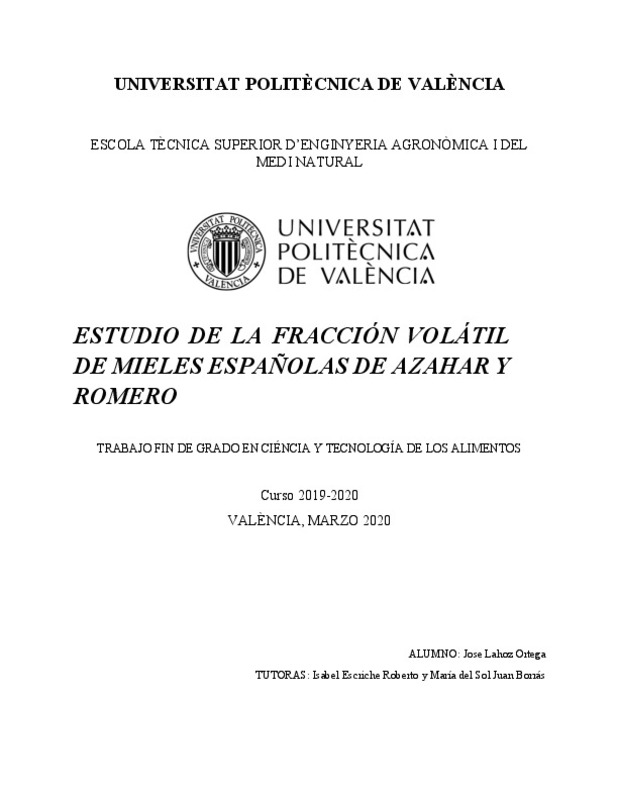|
Resumen:
|
[ES] Las mieles monoflorales son muy apreciadas por sus características organolépticas y, por ello, tienen mayor valor comercial que las de milflores. Disponer de herramientas que autentifiquen inequívocamente su procedencia ...[+]
[ES] Las mieles monoflorales son muy apreciadas por sus características organolépticas y, por ello, tienen mayor valor comercial que las de milflores. Disponer de herramientas que autentifiquen inequívocamente su procedencia botánica es una prioridad para la Administración y para el sector apícola. A nivel comercial, las denominaciones específicas para las mieles monoflorales se hace atendiendo al contenido polínico de la especie botánica predominante. Se trata de un procedimiento muy laborioso, que requiere de personal muy entrenado y, por lo tanto, difícil de llevar como método de rutina. Además, no existe ningún criterio legal para relacionar dicho contenido polínico con una determinada variedad de miel. El presente trabajo forma parte de la segunda campaña de un estudio que el LABMIEL (Laboratorio de la miel y los productos apícolas de la UPV) está realizando junto con el MAPA (Ministerio de Agricultura, Pesca y Alimentación) con la finalidad de determinar los parámetros que caracterizan las principales mieles monoflorales españolas. Por todo ello, el objetivo del presente trabajo se ha centrado en la caracterización mieles monoflorales de romero y azahar, procedentes de diferentes puntos de la geografía española, en términos de su perfil volátil (analizado por Cromatografía de Gases- Espectrometría de Masas), con la finalidad de disponer de información que ayude a la clasificación de estas variedades españolas de miel. Se han identificado 28 compuestos mayoritarios, pertenecientes a 8 familias químicas: 11 alcoholes, 8 aldehídos, 4 cetonas, 2 furanos, 1 compuestos azufrado, 1 terpeno y 1 compuesto nitrogenado. El grupo de los Lilac aldehydes (A, B, C y D) está presente únicamente en la miel de azahar, con una abundancia superior al 20% del total de la fracción volátil de esta variedad de miel. En las mieles de romero se han identificado cuatro compuestos (Isopropyl alcohol; 2-Butenal,2-methyl-; Benzaldehyde; Disulfide,dimethyl) que no estaban en las muestras de azahar, si bien en conjunto representan menos del 3% del total de su fracción volátil. En la variedad de romero, los alcoholes destacan por su abundancia representando más del 43% del total de la fracción volátil (correspondiendo solo al Ethanol el 23% de dicha fracción). En la miel de azahar, los alcoholes, están presentes en menor proporción (aprox el 18% del total). Un análisis multivariante de Componentes Principales (PCA) ha mostrado evidencias claras de que la fracción volátil es capaz de discriminar las mieles por variedad botánica, siendo insignificante la diferencia por procedencia geográfica dentro de una misma variedad. En definitiva, este trabajo pone en evidencia la importancia de la información que proporciona la fracción volátil como una herramienta útil para su clasificación monofloral de las mieles.
[-]
[EN] Monofloral honeys are highly valued for their organoleptic characteristics and, therefore, have greater commercial value than those of mixed flowers. Having tools that unequivocally authenticate its botanical provenance ...[+]
[EN] Monofloral honeys are highly valued for their organoleptic characteristics and, therefore, have greater commercial value than those of mixed flowers. Having tools that unequivocally authenticate its botanical provenance is a priority for the Administration and for the beekeeping sector. At the commercial level, the specific names for monofloral honeys are made according to the pollen content of the predominant botanical species. It is a very laborious procedure, which requires highly trained personnel and, therefore, difficult to carry out as a routine method. Furthermore, there is no legal criterion for relating said pollen content to a certain variety of honey. This work is part of the second campaign of a study that the LABMIEL (Laboratory of honey and apicultural products of the UPV) is conducting together with the MAPA (Ministry of Agriculture, Fisheries and Food) in order to determine the parameters that characterize the main Spanish monofloral honeys. For all these reasons, the objective of this work has focused on the characterization of monofloral rosemary and orange blossom honeys, coming from different points of the Spanish geography, in terms of their volatile profile (analyzed by Gas Chromatography- Mass Spectrometry), with the purpose of having information that helps the classification of these Spanish varieties of honey. 28 major compounds have been identified, belonging to 8 chemical families: 11 alcohols, 8 aldehydes, 4 ketones, 2 furans, 1 sulfur compounds, 1 terpene and 1 nitrogenous compound. The group of Lilac aldehydes (A, B, C and D) is present only in orange blossom honey, with an abundance of more than 20% of the total volatile fraction of this variety of honey. Four compounds (Isopropyl alcohol; 2-Butenal, 2-methyl-; Benzaldehyde; Disulfide, dimethyl) have been identified in rosemary honeys that were not in the orange blossom samples, although together they represent less than 3% of the total its volatile fraction. In the rosemary variety, alcohols stand out for their abundance, representing more than 43% of the total volatile fraction (only 23% of said fraction corresponds to Ethanol). In orange blossom honey, alcohols are present in a smaller proportion (approximately 18% of the total). A multivariate analysis of Principal Components (PCA) has shown clear evidence that the volatile fraction is capable of discriminating honeys by botanical variety, the difference by geographical origin within the same variety being insignificant. In short, this work highlights the importance of the information provided by the volatile fraction as a useful tool for its monofloral classification of honeys.
[-]
|




![PDF file [Pdf]](/themes/UPV/images/pdf.png)



